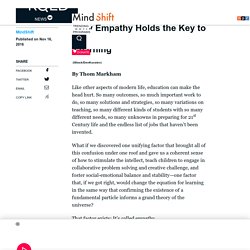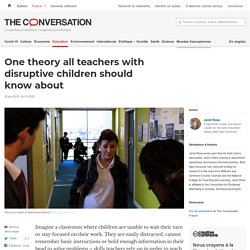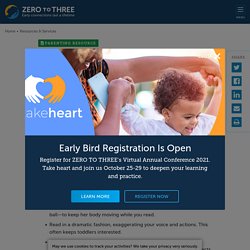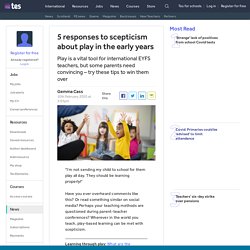

Public Media for Northern CA. To make that argument requires a deep dive into the profound nature of empathy.

Right now, empathy roughly equates to “I like you and am willing to tolerate you regardless of differences because I am a good person.” But the textbook definition hints at something more profound: It’s ‘the feeling of being able to understand and share another person’s experiences and emotions.’ That all-encompassing definition means empathy results from a complex mix of other meaningful emotions and attitudes that fuel human personality, such as openness, curiosity, self-restraint, vulnerability, sensitivity, awareness, respect, appreciation, and even love. Can Free Play Prevent Depression and Anxiety In Kids? One theory all teachers with disruptive children should know about. Imagine a classroom where children are unable to wait their turn or stay focused on their work.

They are easily distracted, cannot remember basic instructions or hold enough information in their head to solve problems – skills teachers rely on in order to teach successfully. These behavioural issues are all examples of problems that can arise from attachment issues – based on the relationship between children and their main caregiver. Attachment theory is now one of the world’s most well-researched theories about human development. It was first proposed by the 20th-century British psychiatrist John Bowlby, who considered that children needed to develop a secure attachment with their main caregiver via sufficiently consistent, responsive, sensitive, appropriate and predictable care and support.
This ‘Kindness Curriculum’ Is Free And Should Be Used In Every Classroom. Imagine living in a world that valued kindness enough to teach it along with academics. Educators would teach kids to manage their emotions in addition to standard curriculum such as math and science. Sounds pretty amazing, doesn’t it? Well, the Center for Healthy Minds at the University of Wisconsin-Madison has created a free “kindness curriculum” for kids, designed to do just that. It’s a mindfulness-based curriculum for preschoolers that will bring kindness into the classroom. “Faced with mental and physical health challenges at a global scale, we conduct rigorous scientific research to bring new insights and tools aimed at improving the wellbeing of people of all backgrounds and ages,” states the Center’s mission statement.
So how exactly does that work? Using “Peace Wands” The children in this program use peace wands to help with conflict resolution. The child with the heart wand describes what they’re feeling “in their heart.” Creating ‘Kindness Gardens’ “Belly Buddies” If Gentle Discipline Isn't Working, This Might Be the Reason - Janet Lansbury. If you’re reading here because you’re committed to guiding your child’s behavior without spankings or punishments, I salute you, especially if you were punished as a child and are looking for a better way.

Setting limits without punishments works. In fact, it works so beautifully that you’ll find you need to set fewer and fewer limits, especially once the toddler years have passed. Many of you have sent me inspiring stories about the positive results you are experiencing, often immediately. I also hear a lot about what isn’t working from parents who believe they are practicing gentle discipline. Parents share about behavior that might have started as minor testing but has become more aggressive, destructive, defiant or deliberate. NQS_PLP_E-Newsletter_No36. EducatorsEn. Background_to_the_Concept_of_Schema.
Positive Learning Environment - Primary. Positive Learning Environment - Primary. Serve and Return. Does my toddler have a short attention span because she won’t sit still for a... A: It is perfectly normal for toddlers to not sit still very long—period.

Most don’t like to stay in one place for long now that they can explore in so many new ways—by running, jumping, and climbing. So, an adult’s idea of snuggling on the couch to hear a story may not be the same idea a toddler has for story-time. Does my toddler have a short attention span because she won’t sit still for a... Poems for kids.
Nursery Rhymes and Songs - BBC Teach. Music and Movement Activities for Toddlers and Preschoolers. 50+ Quick & Easy Kids Crafts that ANYONE Can Make! Songs for kids. How to teach children English using illustrated storybooks.
What makes illustrated storybooks such a good resource for teaching young learners of English? The British Council’s Gail Ellis, co-author of a storytelling handbook for primary English language teachers, explains. Listen to an interview with Gail in our podcast and register for her webinar taking place on Thursday, 2 October. Illustrated storybooks provide an ideal resource for helping children learn English. This is because children love listening to stories. Storybooks present language in familiar and memorable contexts, and high quality illustrations help children understand as they match what they hear to what they see.
Why use storybooks in the classroom? Teachers can use storybooks to complement an English language course or as the main teaching resource. Storybooks can meet a variety of learner needs Selecting the right storybook. How to teach children English using illustrated storybooks. Children-under-5-walking. Ey_making_mark_matters76708_1_ Activities Guide: Enhancing & Practicing Executive Function Skills. Executive function and self-regulation (EF/SR) skills provide critical supports for learning and development, and while we aren’t born with these skills, we are born with the potential to develop them through interactions and practice.

This 16-page guide (available for download, below), describes a variety of activities and games that represent age-appropriate ways for adults to support and strengthen various components of EF/SR in children. Each chapter of this guide contains activities suitable for a different age group, from infants to teenagers. The guide may be read in its entirety (which includes the introduction and references) or in discrete sections geared to specific age groups. Suggested citation: Center on the Developing Child at Harvard University (2014). NQS_PLP_E-Newsletter_No43. 5 ways to win over parents to the importance of play in international EYFS. "I’m not sending my child to school for them play all day.

They should be learning properly! " Have you ever overheard comments like this? Or read something similar on social media? Perhaps your teaching methods are questioned during parent-teacher conferences? Wherever in the world you teach, play-based learning can be met with scepticism. Pts-why-play-is-important. Chat Health 0-5. Multilingual Preschoolers. It’s amazing how young children learn to converse with others. They have to not only internalize grammar and vocabulary, but also develop an understanding of culture: how to take turns in a conversation, who to talk to, and how to narrate a story. For dual language learners (DLLs) — children under the age of 5 with a home language other than English — that process can be complex.
These young children must constantly navigate between two languages and cultures, while learning the rules of both. And while the benefits of multilingualism are clear, these learners they may be excluded or teased because of their differences, which can hinder their development. As linguistic diversity skyrockets worldwide, early childhood educators need to be prepared to help DLL students meet and overcome these unique challenges. The Diversity of Languages in Early Education. Learning_through_play_ey.
Untitled 2. Eal_guidance. Small Talk. Hungry Little Minds – Simple fun, activities for kids aged 0 – 5. Words for Life - Home. Free-Resources_School-Readiness-Poster_OUTLINES_A4_WEB-VERSION. ThePowerofPlay.